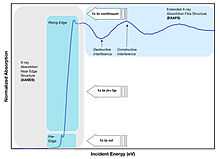X-ray absorption spectroscopy


X-ray absorption spectroscopy (XAS) is a widely used technique for determining the local geometric and/or electronic structure of matter. The experiment is usually performed at synchrotron radiation sources, which provide intense and tunable X-ray beams. Samples can be in the gas-phase, solution, or condensed matter (i.e. solids).
XAS data are obtained by tuning the photon energy using a crystalline monochromator to a range where core electrons can be excited (0.1-100 keV photon energy). The "name" of the edge depends upon the core electron which is excited: the principal quantum numbers n=1, 2, and 3, correspond to the K-, L-, and M-edges, respectively. For instance, excitation of a 1s electron occurs at the K-edge, while excitation of a 2s or 2p electron occurs at an L-edge (Figure 1) [1].
There are three main regions found on a spectrum generated by XAS data (Figure 2). 1) The "absorption threshold" determined by the transition to the lowest unoccupied states : a) the states at the Fermi energy in metals giving a "rising edge" with an invtan shape; b) the bound core excitons in insulators with a Lorentzian line-shape (they occur in a pre-edge region at energies lower than the transitions to the lowest unoccupied level); 2) The X-ray Absorption Near-Edge Structure XANES introduced in 1980 and later in 1983 called also NEXAFS (Near-edge X-ray Absorption Fine Structure) which are dominated by core transitions to quasi bound states (multiple scattering resonances) for photoelectrons with kinetic energy in the range from 10 to 150 eV above the chemical potential, called "shape resonances" in molecular spectra since they are due to final states of short life-time degenerate with the continuum with the Fano line-shape. In this range multi-electron excitations and many-body final states in strongly correlated systems are relevant; 3) In the high kinetic energy range of the photoelectron the scattering cross-section with neighbor atoms is weak and the absorption spectra are dominated by EXAFS (Extended X-ray Absorption Fine Structure) where the scattering of the ejected photoelectron off neighboring atoms can be approximated by single scattering events. After it was shown in 1985 that multiple scattering theory can interpret both XANES and EXAFS the experimental analysis focusing on both regions is called XAFS [2].
XAS is a type of absorption spectroscopy from a core initial state with a well defined symmetry therefore the quantum mechanical selection rules select the symmetry of the final states in the continuum which usually are mixture of multiple components. The most intense features are due to electric-dipole allowed transitions (i.e. Δℓ = ± 1) to unoccupied final states. For example, the most intense features of a K-edge are due to core transitions from 1s → p-like final states, while the most intense features of the L3-edge are due to 2p → d-like final states.
XAS methodology can be broadly divided into four experimental categories that can give complementary results to each other: Metal K-edge, metal L-edge, ligand K-edge, and EXAFS.
Applications
XAS is a technique used in different scientific fields including molecular and condensed matter physics, materials science and engineering, chemistry, earth science, and biology. In particular, its unique sensitivity to the local structure, as compared to x-ray diffraction, have been exploited for studying:
- Amorphous solids and liquid systems
- Solid solutions
- Doping and ion implantation materials for electronics
- Local distortions of crystal lattices
- Organometallic compounds
- Metalloproteins
- Metal clusters
- Catalysis
- Vibrational dynamics
- Ions in solutions
- Speciation of elements
- Liquid water and aqueous solutions
History
An informative account about the history of XAS is given in the paper "A History of the X-ray Absorption Fine Structure" by R. Stumm von Bordwehr, Ann. Phys. Fr. vol. 14, 377-466 (1989) (author's name is C. Brouder).
References and external links
[1] http://chemwiki.ucdavis.edu/Physical_Chemistry/Spectroscopy/X-ray_Spectroscopy/XANES%3A_Theory
[2] http://xafs.org/Tutorials?action=AttachFile&do=view&target=Newville_xas_fundamentals.pdf